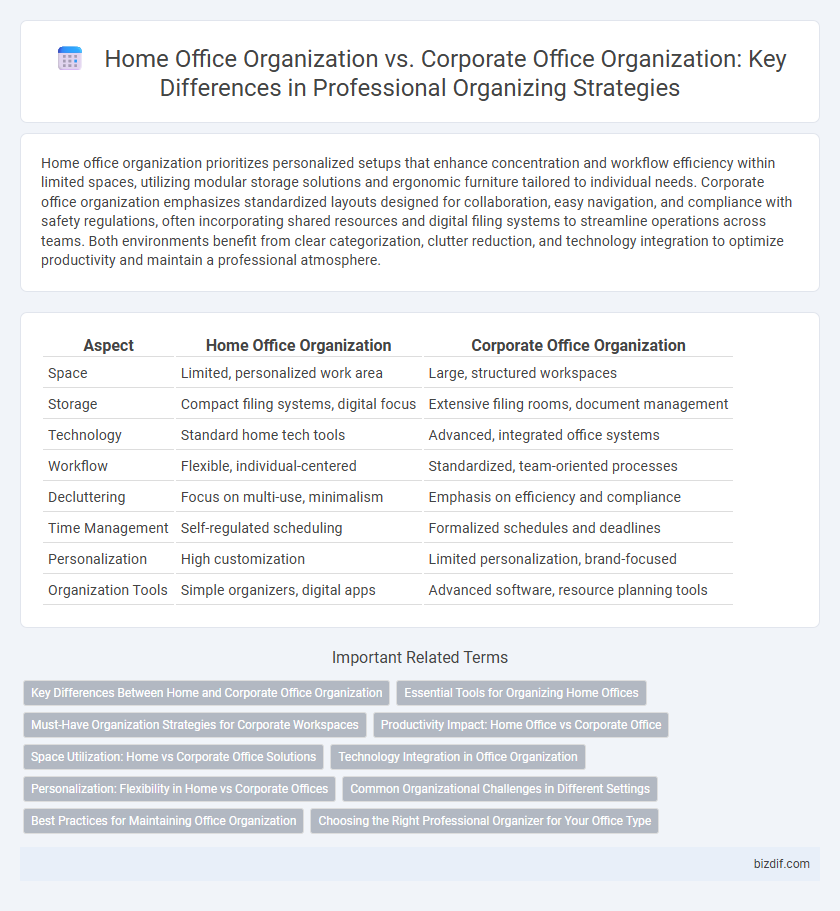Home office organization prioritizes personalized setups that enhance concentration and workflow efficiency within limited spaces, utilizing modular storage solutions and ergonomic furniture tailored to individual needs. Corporate office organization emphasizes standardized layouts designed for collaboration, easy navigation, and compliance with safety regulations, often incorporating shared resources and digital filing systems to streamline operations across teams. Both environments benefit from clear categorization, clutter reduction, and technology integration to optimize productivity and maintain a professional atmosphere.
Table of Comparison
| Aspect | Home Office Organization | Corporate Office Organization |
|---|---|---|
| Space | Limited, personalized work area | Large, structured workspaces |
| Storage | Compact filing systems, digital focus | Extensive filing rooms, document management |
| Technology | Standard home tech tools | Advanced, integrated office systems |
| Workflow | Flexible, individual-centered | Standardized, team-oriented processes |
| Decluttering | Focus on multi-use, minimalism | Emphasis on efficiency and compliance |
| Time Management | Self-regulated scheduling | Formalized schedules and deadlines |
| Personalization | High customization | Limited personalization, brand-focused |
| Organization Tools | Simple organizers, digital apps | Advanced software, resource planning tools |
Key Differences Between Home and Corporate Office Organization
Home office organization prioritizes personalized space optimization, focusing on flexibility, comfort, and adapting to multi-use environments, whereas corporate office organization emphasizes standardized layouts, efficient workflow, and adherence to professional ergonomics. Storage solutions in home offices typically cater to smaller volumes and diverse personal items, while corporate offices require scalable, uniform systems to accommodate extensive filing and collaboration needs. Time management tools and technology integration in corporate offices often support complex project coordination, contrasting with the simpler, individualized systems favored in home settings.
Essential Tools for Organizing Home Offices
Essential tools for organizing home offices include ergonomic furniture, space-saving storage solutions like vertical shelves and filing cabinets, and digital organization apps for task and document management. High-speed internet, cable organizers, adjustable lighting, and noise-canceling headphones enhance productivity and comfort in a personalized workspace. Unlike corporate offices, home office setups prioritize multi-functional and compact tools tailored to limited space and individual work styles.
Must-Have Organization Strategies for Corporate Workspaces
Effective corporate office organization hinges on scalable storage systems, clear labeling protocols, and designated zones for collaborative work and focused tasks. Implementing digital document management and standardized filing systems reduces clutter and enhances accessibility across large teams. Prioritizing ergonomic furniture and cable management solutions supports productivity and maintains a professional environment throughout the workspace.
Productivity Impact: Home Office vs Corporate Office
Home office organization enhances productivity by offering personalized layouts tailored to individual work styles, minimizing distractions, and facilitating flexible schedules. Corporate office organization prioritizes standardized workflows and collaborative spaces that support team communication and centralized resource access. Both environments influence productivity differently, with home offices fostering focused autonomy and corporate offices driving structured interaction.
Space Utilization: Home vs Corporate Office Solutions
Home office organization maximizes limited square footage by incorporating multi-functional furniture and personalized storage solutions tailored to individual workflows. Corporate office organization emphasizes optimizing large-scale layouts through modular systems, ergonomic workstations, and centralized storage to enhance team collaboration and operational efficiency. Space utilization in corporate settings prioritizes scalability and standardization, while home offices focus on adaptability and comfort within constrained environments.
Technology Integration in Office Organization
Home office organization emphasizes personalized technology integration, incorporating ergonomic setups, multi-device connectivity, and user-friendly software to enhance productivity in limited spaces. Corporate office organization prioritizes scalable technology infrastructure, including centralized data management, advanced communication systems, and enterprise-grade security protocols to support large teams and complex workflows. Optimizing technology integration in both settings improves efficiency, reduces downtime, and streamlines task management.
Personalization: Flexibility in Home vs Corporate Offices
Home office organization allows for high personalization and flexibility, adapting to individual work habits, ergonomic preferences, and aesthetic tastes, enhancing comfort and productivity. Corporate office organization typically follows standardized systems and layouts to ensure uniformity, streamline collaboration, and maintain brand consistency across teams. Balancing personal flexibility with organizational policies in corporate environments often requires integrating adjustable furniture and modular storage solutions.
Common Organizational Challenges in Different Settings
Common organizational challenges in home office settings include limited space, distractions from household activities, and lack of ergonomic furniture, which affect productivity and focus. In corporate office environments, challenges center around coordinating shared resources, managing cluttered communal areas, and maintaining consistent filing systems across teams. Both settings require tailored strategies to optimize workflow and ensure efficient use of physical and digital organizational tools.
Best Practices for Maintaining Office Organization
Effective home office organization involves personalized storage solutions, minimizing clutter through regular purging, and maintaining digital file systems tailored to individual workflows. Corporate office organization prioritizes standardized filing protocols, shared resource accessibility, and clear labeling to support team collaboration and efficiency. Both environments benefit from routine maintenance schedules and the adoption of ergonomic design principles to enhance productivity and reduce stress.
Choosing the Right Professional Organizer for Your Office Type
Selecting a professional organizer for home office organization requires expertise in personalized space optimization, tailored storage solutions, and flexible workflow arrangements that enhance individual productivity. For corporate office organization, prioritize organizers experienced in managing large-scale projects, implementing uniform filing systems, and fostering collaborative environments to boost team efficiency. Understanding the specific needs of your office type ensures the chosen professional can deliver customized strategies that maximize functionality and organization.
Home Office Organization vs Corporate Office Organization Infographic

 bizdif.com
bizdif.com